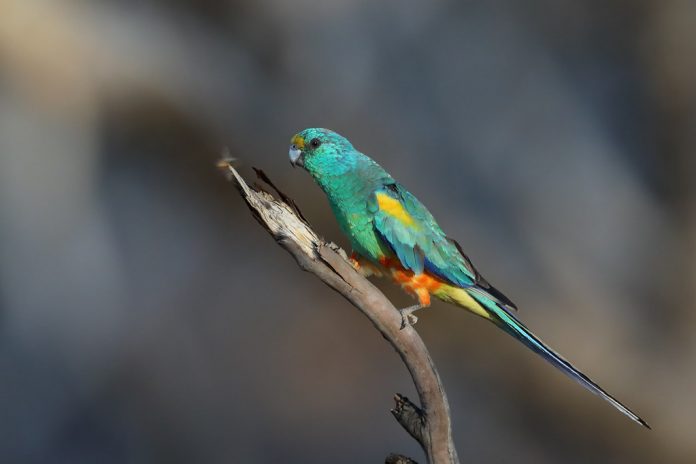A quieter and less obtrusive, Mulga Parrots replace their close relative, the Red-rumped Parrot, in the drier mallee and mulga woods of the western and southern inland. As well to their more varied coloring and red-shouldered females, they also appear more slender because of their long tails.
They rarely flock, but pairs or family parties of up to eight often gather to feed where food is plentiful-at a railway siding where the grain has been spilled, for example. Most feeding is done on the ground, where they search for the seeds of grasses, herbaceous plants and shrubs, and berries. Like other parrots of arid regions, Mulga Parrots forage early in the morning and late in the afternoon, and usually drink then.
During the hottest part of the day, they sit quietly among the branches of a tree, their plumage blending well with the foliage. The birds fly swiftly, close to the ground, with a buoyant, slightly undulating flight, gliding regularly on folded wings. On alighting, they fan their tails. They may wander more widely than Red-rumped Parrots in search of food, and their numbers fluctuate wildly in some areas.
In recent years they seem to have declined in southern regions, probably because of the clearing of mallee for wheat farming. Display and courtship feeding match those of the Red-rumped Parrot, and the sexes preen one another as well. The male, however, stays close to the nest-foraging nearby while his mate is brooding, not joining other males in feeding groups, and calling loudly at any approaching threat. Mulga Parrot is also known as Many-coloured Parrot.
Mulga Parrot is 270-280 mm in length, including a long tapered tail. MALE: General plumage bright bluish-green. The forehead is yellow; red patch on the nape. The shoulder patch is yellow; underwing coverts, bend of the wing, primary coverts, and outer webs of flight feathers are rich blue. The rump and upper tail coverts are green; red patch near the base of the tail, a vague yellow-green band above it, and then a dark blue-green band on top towards the back.
Throat and breast rich bluish-green: belly and thighs yellow strongly washed with red. Vent and undertail coverts green-yellow. Central tail feathers are dark-green washed with blue; all outer tail feathers are blue broadly tipped with white. Eyes are brown with bill leaden; cere dark grey. Their feet and claws are dark gray.
FEMALE: Forehead dull orange-ye/low; dull red patch on the crown. Head, neck, back, and upper breast brown-green; rest of underparts pale green: rump pale green with the red patch at the base. Wings dull green grading to blue flight feathers; dull red shoulder patch; off-white underwing bar rather persistent. Tail same as male but duller and eye, bill, and feet as male. IMMATURES: Resemble adults.
In young males, the red of the belly and thighs is reduced or absent and there are red tinges on shoulder patches, but the off-white underwing bar is variably persistent. Young gain adult plumage at first complete moult two-three months after fledging. White underwing bar remains in males for another year. DOWNY YOUNG: White-downed, buff-billed.
Mulga Parrot contact calls a mellow flute-like whistle repeated quickly three or four times, often in flight. The parrot is occasionally soft chattering in display and when feeding. Though, it is commonly a silent bird.
The breeding season starts in July-December, but in the north and west of the range at any time after good rains. A nest is a hollow high in a tree or as low as 2-3 m above ground. Eggs: four to six, usually five; white; rounded, 24-25 x 1 8- 1 9 mm. Laid on a bed of wood dust. The incubation period is 19 days, by female, and young fledge the nest in about four weeks.
Mulga Parrot is widespread in the lightly timbered countries in western and southern inland Australia. South and east to limits of mallee in Western Australia, South Australia, Victoria, and New South Wales, and north to main limits of mulga in Pilbara, central Australia, and western Queensland. Sedentary except in arid areas, where birds may congregate and breed after rain. No races.
Related Reading – Alexandra’s Parrot (Polytelis alexandrae)












